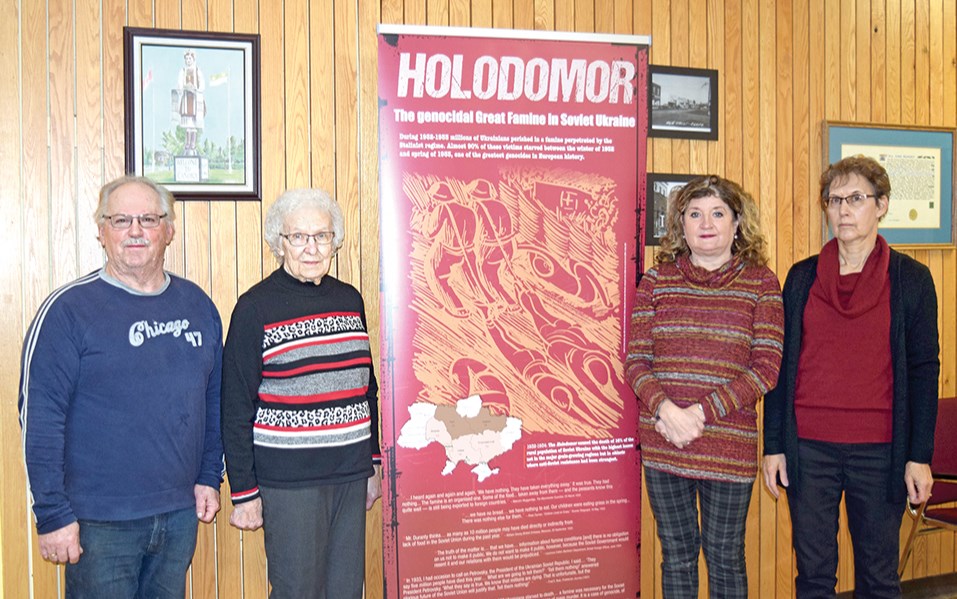Both Canora’s town office and the local MLA marked National Holodomor Awareness Week.
The week took place Nov. 20-26. According to Wikipedia, the Holodomor, also known as the Great Ukrainian Famine, was a man-made famine in Soviet Ukraine from 1932 to 1933 that killed millions of Ukrainians.
Canora town council recognized this anniversary by displaying a Holodomor banner created by Professor Lubomyr Luciuk for the Ukrainian Canadian Civil Liberties Foundation during Holodomor Week.
“It’s the 90th anniversary of Holodomor,” said Canora Councillor Denise Leslie. “It’s good to have it at the town office for the public to see and be reminded. Lots of people come to the town office.”
The following is included in the information found on the banner for the public to read:
“Between 1932 and 1933, five million Ukrainians starved to death. A famine was necessary for the Soviet Union and so they got one to order, by plan. This is not simply a case of mass murder. It is a case of genocide, of the destruction, not of individuals only, but of a culture and of a nation.”
“During 1932 to 1933, millions of Ukrainians perished in a famine perpetrated by the Soviet Stalinist regime. Almost 90 per cent of these victims starved in the winter of 1932 and spring of 1933, one of the greatest genocides in European history.”
“We have no bread. We have nothing to eat. Our children were eating grass in the spring. There was nothing else for them,” wrote journalist Rhea Clyman in a Toronto Telegram article published May 16, 1933. Clyman was one of the first western journalists to witness and report on the starvation in Ukraine.
Information published by the Ukrainian Canadian Congress National Holodomor Awareness Committee:
- The Soviet regime dumped 1.7 million tons of grain on the Western markets at the height of the Holodomor.
- At the height of the Holodomor, Ukrainian villagers were dying at the rate of 25,000 per day or 1,000 per hour or 17 per minute.
- Children comprised one-third of the Holodomor victims in Ukraine. Large numbers of children were orphaned and became homeless.
- The Ukrainian population was reduced by as much as 25 per cent.
The Province of Saskatchewan commemorated the Holodomor with a special service at the Legislative Building on Nov. 21. Legislative Secretary Responsible for Saskatchewan-Ukrainian Relations Terry Dennis, joined with members of the province's Ukrainian community to commemorate the millions who died during the 1932-33 famine in Ukraine.
"Holodomor, the Great Famine, is still felt by the Ukrainian community 90 years later," Dennis said in a release. "We join our Saskatchewan citizens of Ukrainian heritage to remember this dark time and honour those lost."
The word Holodomor means "extermination by hunger" in the Ukrainian language. The service was held in solidarity with Holodomor Memorial Week; a memorial candle was lit and remained lit throughout the week to represent unity with those around the world marking the Holodomor genocide.
In 1932 and 1933, the man-made famine engineered by the Soviet government resulted in the deaths of millions of people through starvation and deprivation. Crops were confiscated and regulations were imposed preventing people from leaving their communities in search of food.
An exact reproduction of the statue, entitled "Bitter Memories of Childhood" by sculptor Preto Drozdowsky, of a young, starving peasant girl clutching a wheat sheaf, was dedicated on the grounds of Wascana Centre. The original statue still stands in the National Museum of the Holodomor-Genocide in Kyiv, Ukraine.
The statue is located southeast of the Legislative Building on Lakeshore Drive, serving as a permanent reminder of the tragedy.
This year marks the 15th year the Government of Saskatchewan has recognized Holodomor Memorial Week. Saskatchewan was the first jurisdiction in North America to recognize this genocide with the passing of The Ukrainian Famine and Genocide (Holodomor) Memorial Day Act in 2008.
International Holodomor Day is recognized on the fourth Saturday of November and, this year, fell on Nov. 25.
Don't count on social media to deliver your local news to you. Keep your news a touch away by bookmarking Canora Courier's homepage at this link.
Bookmark SASKTODAY.ca, Saskatchewan's home page, at this link.




